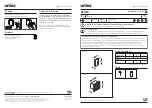
PERSONAL SAFETY
POWER TOOL USE AND CARE
SERVICE
d) Remove any adjusting key or wrench before turning the power tool on.
A wrench or a key left attached to a rotating part of the power tool may result in personal injury.
e) Do not overreach. Keep proper footing and balance at all times.
This enables better control of the power tool in unexpected situations.
f) Dress properly. Do not wear loose clothing or jewelry. Keep your hair, clothing and gloves away from moving parts.
Loose clothes, jewelry or long hair can be caught in moving parts.
g) If devices are provided for the connection of dust extraction and collection facilities,ensure these are connected and properly used.
Use of dust collection can reduce dust-related hazards.
a) Do not force the power tool. Use the correct power tool for your application.
The correct power tool will do the job better and safer at the rate for which it was designed.
b) Do not use the power tool if the switch does not turn it on and off.
Any power tool that cannot be controlled with the switch is dangerous and must be repaired.
c) Disconnect the plug from the power source and/or the battery pack from the power tool before making any adjustments,
changing accessories, or storing power tools.
Such preventive safety measures reduce the risk of starting the power tool accidentally.
d) Store idle power tools out of the reach of children and do not allow persons unfamiliar with the power tool or these instructions
to operate the power tool.
Power tools are dangerous in the hands of untrained users.
e) Maintain power tools. Check for misalignment or binding of moving parts, breakage of parts, and any other condition that may affect
the power tools operation. If damaged, have the power tool repaired before use.
Many accidents are caused by poorly maintained power tools.
f) Keep cutting tools sharp and clean.
Properly maintained cutting tools with sharp cutting edges are less likely to bind and are easier to control.
g) Use the power tool, accessories and tool bits etc. in accordance with these instructions, taking into account the working conditions
and the work to be performed.
Use of the power tool for operations different from those intended could result in a hazardous situation.
a) Have your power tool serviced by a qualified repair person using only identical replacement parts.
This will ensure that the safety of the power tool is maintained.
Page 2
1.
Never attempt to open for any reason.
2.
Do not store in locations where the temperature may exceed 40 °C.
3.
Charge only at ambient temperatures between 4 °C and 40 °C.
4.
Charge only using the charger provided with the tool.
5.
Do not cause short circuits. If connection is made between the positive (+) and negative (-) terminal directly or via accidental contact with metallic
objects, the battery is short circuited and an intense current will flow causing heat generation which may lead to casing rupture or fire.
6.
Do not heat. If batteries are heated to above 100 °C, sealing and insulating separators and other polymer components may be damaged resulting in
electrolyte leakage and/or internal short circuiting leading to heat generation causing rupture or file. Moreover, do not dispose of the batteries in fire, as
explosion and/or intense burning may result.
7.
Under extreme conditions, battery leakage may occur. When you notice liquid on the battery, proceed as follows:
• Carefully wipe the liquid off using a cloth. Avoid skin contact.
8.
In case of skin or eye contact, follow the instructions below:
• In case of eye contact, rinse abundantly with clean water for at least 10 minutes. Consult a physician.
FIRE HAZARD!:
Avoid short-circuiting the contacts of a detached battery. Do not incinerate the battery.
BATTERY SAFETY
























